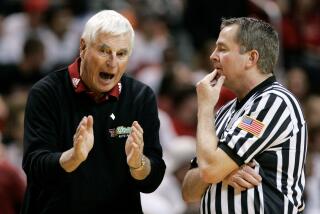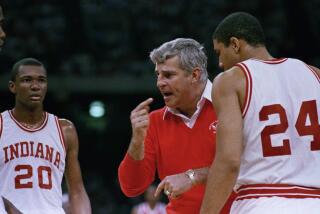The Authorized John S. Knight : KNIGHT : Publisher in the Tumultuous Century <i> (by Charles Whited E. P. Dutton: $21.95; 389 pp.; illustrated; 0-525-24723-8) </i>
- Share via
Author Charles Whited likes short sentences. He uses many of them in his biography of newspaper publisher John S. Knight. The copyright on his book is held by the Knight Foundation. This may be all you need to know.
“Knight, Publisher in the Tumultuous Century” (E. P. Dutton) outlines the public successes of the man who fashioned one of the nation’s leading press empires. Knight, who died at age 86 in 1981, had a chain of private sorrows as well--his first wife Katie died in 1929, leaving him with three small children; his second son Landon was crippled with polio at age 9; his oldest son and namesake, an Army lieutenant, was killed six weeks before the Germans surrendered in 1945; his third son Frank died of a brain tumor at 30; and his grandson, John S. Knight III, was brutally murdered.
After military service in France during World War I, Knight started working at his father’s paper, the Akron Beacon Journal. At first, he wrote so poorly that he used a pseudonym on his early sports stories. He eased into writing a column in 1936 with a modest seven-paragraph item about a local Community Chest drive. By then he was president and editor of the Beacon Journal.
Over the years he wrote about everything from his receding hairline and people who made him tired to Franklin Roosevelt’s moves away from neutrality on the eve of World War II. Knight was a firm defender of hemispheric press freedom, spurred on initially by Juan Peron’s suppression of La Prensa in Argentina. Later he opposed American involvement in Vietnam and defended those who dissented from the war. In 1968 he was awarded a Pulitzer Prize.
In 1937 the Knight organization bought the Miami Herald. Knight’s younger brother James took charge of that paper but John was always the more visible brother. So visible that sometimes it was embarrassing because he liked to gamble--he vastly increased his World War I pay shooting dice--even as the Herald was trying to clean up Miami’s corrupt reputation. The Herald ultimately won a Pulitzer Prize for its crusade while Knight was criticized by opponents who called him a hypocrite. “Knight shoots a thousand dollars in a crap game, but says it’s wrong for Joe Blow to play pennies,” one newspaper thundered.
By 1940 the Knight organization had acquired the Detroit Free Press. Later it would buy and then sell the Chicago Daily News as well as purchase the Charlotte Observer, the Tallahassee Democrat, the Macon Telegraph and News, the Philadelphia Inquirer, and the Lexington Herald-Leader. Merging with the Ridder chain of papers in 1974, the organization became known as Knight-Ridder and now includes the San Jose Mercury News, Pasadena Star-News and Long Beach Press-Telegram.
When Knight died, his newspapers’ revenue exceeded $1 billion and his personal holdings were worth $200 million--yet he had to be persuaded by one of his executives, Lee Hills, to expand the Knight Foundation to benefit arts institutions and further journalists’ mid-career educations. Knight had once pronounced: “I have no interest in the foundation. I’m not going to leave it anything.” He changed his mind, and Stanford University’s professional journalism program is now named after him.
Whited, a columnist for the Miami Herald, has done what obviously was expected of him. The book puts on the record how the Knight organization expanded. But there are several fundamental changes in the tumultuous century about which there’s little or no way of telling how Knight felt. The emergence of blacks and women into fuller participation in the political, economic and educational arenas of American life is one of the profound changes of the second half of the 20th Century. You wouldn’t know it from Whited’s book. The only reference comes when Knight backed the editorials in the Charlotte Observer on school desegregation.
Other than his mother, his wives and his stepdaughter, women don’t figure in this book. Only three female journalists are mentioned, and those only in passing. Whited didn’t talk, for example, to Dorothy Jurney, a pioneering women’s editor at both Knight’s Miami Herald and the Detroit Free Press.
I asked Jurney what she thought Knight’s strength was. “His determination that you could have a fine editorial product only after you established it as financially sound.” And what troubled her the most when she worked for the organization? That the Herald wasn’t covering the black community in any meaningful way, a situation she tried to correct somewhat.
Newspapers need different, even dissenting, voices. A staff from varied backgrounds covers the news more thoroughly. I know one community; you know another. Did John S. Knight care one way or the other about this fundamental question of newspaper staffing? There’s no answer in this book. Books need dissenting voices, too.
Books should possess a certain grace as well. Yet Chapter 3 starts: “The 1920s roared.” Chapter 5 starts: “Knight admired M. Smith Davis.” The same chapter tells us: “Jackboots tramped in Europe.” Chapter 7 says: “War rumbled beyond the seas.” Chapter 10 begins: “The possibility was enormous.” And Chapter 8’s beginning: “Disaster was afoot. The thing was so palpable you could smell it on the spring air.”
Indeed.
More to Read
Sign up for our Book Club newsletter
Get the latest news, events and more from the Los Angeles Times Book Club, and help us get L.A. reading and talking.
You may occasionally receive promotional content from the Los Angeles Times.








